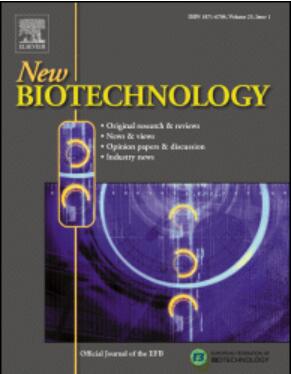Engineering enhanced signal peptides: A high-throughput computational pipeline for optimizing therapeutic protein production in CHO cells
IF 4.9
2区 生物学
Q1 BIOCHEMICAL RESEARCH METHODS
引用次数: 0
Abstract
Rational design of signal peptides (SPs), crucial for efficient therapeutic protein secretion in Chinese hamster ovary (CHO) cells, remains challenging due to their context-dependency activity. To overcome this limitation and enable the discovery of novel high-performance SPs, we developed a high-throughput computational screening pipeline. This approach leverages the deep learning model SignalP 6.0 to screen millions of SP variants derived from diverse mouse/human wild-type libraries and C-region mutants. As a demonstration of its broad applicability, we applied this pipeline to optimize SPs for human serum albumin (HSA) expression. Ranking candidates based on predicted translocation efficiency and cleavage accuracy identified thirty promising SPs outperforming native HSA SP. Experimental validation in CHO cells confirmed multiple novel SPs that significantly enhanced HSA yields, both transiently (e.g., M1_MATN2, 1.93-fold; H5_CXL14, 1.63-fold) and stably (e.g., H5_CXL14, 2.89-fold; M1_MATN2, 1.86-fold). Crucially, our analysis revealed novel insights: hydropathicity profiling uncovered a distinctive and highly effective signature in the top high-performing H5_CXL14 SP, characterized by rapid hydrophobic onset, a continuous highly hydrophobic core, and peak hydrophobicity. Solubility predictions suggested wild-type SPs enhanced secreted protein solubility, while C-region mutants had neutral or negative effects. Furthermore, a novel correlation was observed between high-expression levels and more stable mRNA secondary structures (lower minimum free energy, MFE). This integrated computational-experimental pipeline represents a significant advance, enabling the rational design of protein-specific SP with high efficiency. It drastically reduces the experimental screening burden and holds substantial promise for broadly optimizing therapeutic protein production platforms, as demonstrated here for HSA in CHO cells.
工程增强信号肽:用于优化CHO细胞中治疗性蛋白生产的高通量计算管道。
信号肽(SPs)对中国仓鼠卵巢(CHO)细胞有效的治疗性蛋白分泌至关重要,由于其环境依赖性活性,其合理设计仍然具有挑战性。为了克服这一限制并发现新的高性能SPs,我们开发了一个高通量计算筛选管道。该方法利用深度学习模型SignalP 6.0筛选来自不同小鼠/人类野生型文库和c区突变体的数百万SP变体。为了证明其广泛的适用性,我们应用该管道来优化人类血清白蛋白(HSA)表达的SPs。根据预测的易位效率和切割精度对候选物进行排名,确定了30个有希望的SPs,优于天然HSA SP。CHO细胞的实验验证证实了多个新型SPs,它们显著提高了HSA的产量,既有瞬时的(如M1_MATN2, 1.93倍;H5_CXL14, 1.63倍),也有稳定的(如H5_CXL14, 2.89倍;M1_MATN2, 1.86倍)。至关重要的是,我们的分析揭示了新的见解:疏水性分析揭示了高性能的H5_CXL14 SP的独特而高效的特征,其特征是快速疏水发作,连续的高度疏水核心和疏水性峰值。溶解度预测表明,野生型SPs提高了分泌蛋白的溶解度,而c区突变体具有中性或负作用。此外,高表达水平与更稳定的mRNA二级结构(更低的最小自由能,MFE)之间存在新的相关性。这种集成的计算-实验管道代表了一个重大的进步,使蛋白质特异性SP的合理设计具有高效率。它大大减少了实验筛选负担,并为广泛优化治疗性蛋白生产平台提供了巨大的希望,正如这里在CHO细胞中的HSA所证明的那样。
本文章由计算机程序翻译,如有差异,请以英文原文为准。
求助全文
约1分钟内获得全文
求助全文
来源期刊

New biotechnology
生物-生化研究方法
CiteScore
11.40
自引率
1.90%
发文量
77
审稿时长
1 months
期刊介绍:
New Biotechnology is the official journal of the European Federation of Biotechnology (EFB) and is published bimonthly. It covers both the science of biotechnology and its surrounding political, business and financial milieu. The journal publishes peer-reviewed basic research papers, authoritative reviews, feature articles and opinions in all areas of biotechnology. It reflects the full diversity of current biotechnology science, particularly those advances in research and practice that open opportunities for exploitation of knowledge, commercially or otherwise, together with news, discussion and comment on broader issues of general interest and concern. The outlook is fully international.
The scope of the journal includes the research, industrial and commercial aspects of biotechnology, in areas such as: Healthcare and Pharmaceuticals; Food and Agriculture; Biofuels; Genetic Engineering and Molecular Biology; Genomics and Synthetic Biology; Nanotechnology; Environment and Biodiversity; Biocatalysis; Bioremediation; Process engineering.
 求助内容:
求助内容: 应助结果提醒方式:
应助结果提醒方式:


